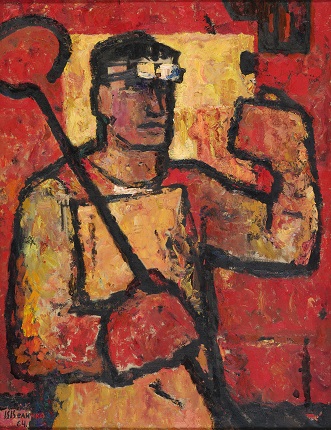Industrial World. The Chelpipe Art Collection Exhibition



V.S. Velichko. Metallurgist. 1964
V. Vyshilov. Press. 1971
A. V. Lentulov. Workers of the Kerch Metallurgical Plant. 1930. Paper, watercolor
O. Kolmakova. At the factory. 1920-30's Canvas, oil 115x128.
A. Labas. Worker. 1958. Paper, mixed media
N. Svoboda Alapaevsk. Factory. 1968
Moscow, 16.09.2017—29.10.2017
exhibition is over
Share with friends
For the press
On September 16, an exhibition will open at MAMM titled ‘The Industrial World. The Collection of the Chelyabinsk Pipe-Rolling Plant,’ presenting works by Soviet artists of the 1920s—1980s alongside works by modern authors — industrial photography and art installations. The exhibition has been organized together with the CPRP to mark the enterprise’s 75th anniversary, and works from its corporate collection, numbering 450 painted canvases and graphic works, will be shown for the first time. The exhibition will run until October 22.
‘The idea that arose in the 1990s of creating a unique ‘painted’ chronicle of Soviet metallurgy developed into a collection of works by recognized masters of the 20th century which, this year, will be presented to the general public at the Multimedia Art Museum, Moscow,’ notes a CPRP shareholder, Andrei Komarov. ‘The works by Soviet authors, placed in the context of works created with the use of modern media technologies, demonstrate the polemic between the ‘old’ industrial and the ‘new’ post-industrial era, showing spectators how the industrial world and art itself have been transformed.’
Among the authors presented in the collection, there are names that are renowned among the general public — Aristarkh Lentulov, Alexander Labas, Moisei Feigin, Nikolai Dormidontov, Yekaterina Zernova, Pyotr Kotov, Pavel Sokolov-Skalya, Leonid Feinberg, Max Birstein and many more. The works presented at MAMM are united by a theme that is important for the art of the 20th century, industrialization, and they show the development of an entire era in Russian visual arts in the last century. At the same time, they reveal the history of Russian industry — first and foremost the metallurgy industry — as seen through the eyes of artists.
The collection details the changes in artistic schools and styles in Soviet art. In the works of Olga Kolmakova, Vladimir Kuchumov, Leonid Feinberg and Yekaterina Zernova the traditions of Russian modernism of the 1920s, with its reverence for technological progress, industrialization and urbanization, are revealed.
In the works of the 1930s—1950s, the socialist realist style that was obligatory in Soviet art from the beginning of the 1930s is triumphant. Thus, for example, in the pictures of Lentulov and Rubanov, the working man is transformed into a titan. The exhibition’s graphic cycle comprises works by artists such as Labas, Lentulov, Usaitis, Stekolshchikov and Duvidov.
In their works, the contemporary artists Dmitry Morozov and Timofei Parshchikov study the theme of industrialization and post-industrialization. Parshchikov’s works, shot at the Chelyabinsk Pipe-Rolling and Pervouralsk New Pipe factories, reveal the new White Metallurgy. The contemporary production of the Chelyabinsk Pipe-Rolling Plant inspired Dmitry Morozov to create a multi-component kinetic and sonic installation titled Pro Sodia. The installation, which embodies a synthesis of art and technological thinking, was the result of joint work by the media-artist and students of the Future of White Metallurgy educational program of the CPRP Group aimed at the training of highly-qualified personnel for the metallurgy sector.
For reference:
The Chelyabinsk Pipe-Rolling Plant is the parent company of one of the largest metallurgy groups in Russia, the CPRP Group, which is the fifth largest in the world in terms of pipe production. The CPRP Group unites metallurgy companies and enterprises, and also comprises another major pipe producer — the Pervouralsk New Pipe Plant. The company supplies products for the fuel-energy complex, machine-building, the construction industry, agriculture and other industrial sectors on the domestic and foreign markets. About 25,000 people work at CPRP.
The company trains qualified personnel for the metallurgy section, carrying out its own educational program, «The Future of White Metallurgy.» The project has been recognized by the Education and Science Ministry of the Russian Federation as the finest practical training for staff, employing a dual education model where 60% of study time is spent on practical exercises.





